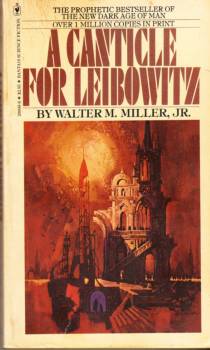
In part one of my review of A Canticle for Leibowitz I provided a plot summary and pointed out how the story focused on the cyclical nature of history. Within that broad theme Miller looked at two more specific recurring conflicts–that of science and religion, and of Church and State, and did so in a somewhat atypical way.
Miller addresses the seemingly inevitable tension between science and religion in a fairly unique way for a work of fiction. What sets his approach apart is his unwillingness to make the conflict one of black and white, and his rejection of demonizing either. One of the foundations of the story in Fiat Homo is the “Simplification”, where those of learning and knowledge (science writ large) were vilified, hunted down, and killed after the first nuclear war, presumably by those who turned to their faith in the aftermath of the Flame Deluge. Yet the Catholic Church, through its support of the monastic Order initiated by the technician Isaac Leibowitz, took on the preservation of knowledge (much as the Church did during the Dark Ages). In Fiat Lux there is an awakening of science, and one of the monks at the Abbey even shows himself to have a healthy dose of scientific intuition, creating an arc lamp (which, interestingly, temporarily replaces a crucifix on the wall). The Order makes their repository of knowledge available to the natural philosophers of the time–but on the Abbey’s terms, as though maintaining control of the knowledge within its walls will ensure its proper use. When Thon Taddeo questions the motives for the Order’s stewardship of the knowledge, he and the Abbot argue whether science should serve God (and therefore be controlled until Man was worthy), or should serve the secular world. Miller leaves this argument unresolved, seeming to say that science, as science, doesn’t necessary conflict with the beliefs of the Church, but rather depends on the use it’s put to. And it seems Miller feels neither is better than the other at using it. Both the distrust of the past by the Thon and his willingness to sanction Hannegan’s acts to further science, and the distrust of the future and seeming unwillingness to make the knowledge they’d preserved easily available to the awakening world by the Abbot, show that Miller thought neither the ideal steward. The Wandering Jew‘s inability to find what he seeks in both the practitioners of science and faith further strengthens that message. This ambiguity remains in the ironic ending to the story, where the preservation of knowledge and the Order are both entrusted to a starship, its faith-based crew, and a colony of men on another planet–turning the wheel of history back to start once again, the question unanswered as to which–science or faith–will have the wherewithal to succeed.
The book similarly takes an ambiguous stance in the treatment of the State vs Church issue. Miller sees an uneasy truce between State and Church at best, and even though it’s clear he feels the State will always take more questionable moral positions, there’s also an ambivalence about the actions of the Church. This underlying, repeating theme shows up in Fiat Lux when the Poet, rather than staying out of the way, takes on a cavalry soldier slaughtering refugees (ostensibly a moral act). After the fight, with both the Poet and the soldier wounded, the Poet hears the wounded soldier’s confession as he stabs him in the throat, killing him (not so moral an act)–then dying himself.
The conflict between Church and State is particularly blatant in the interaction between Texarkana and New Rome in Fiat Lux, and again the State’s actions are portrayed as immoral based on Hannegan’s deceit and lies to his supposed allies. But there’s just a hint of impropriety in Father Apollo’s actions in alerting the Church of his suspicions, and in New Rome’s actions in placing Texarkana under Interdict–then removing it. While Hannegan’s making all the clergy answerable to him within his realm and brutally murdering New Rome’s representative, Father Apollo, show the evil side of the State, Miller again seems to question the acts of the Church as well. Hannegan’s angry proclamation against New Rome includes reference to the “great confusion and spiritual neglect among all the faithful” that New Rome’s flip-flopping on Interdiction caused, which seems out of place among the fiery rhetoric that permeates the rest of the decree.
Later, in Fiat Voluntas Tua, we see a conflict between the rules of the State (on euthanasia for hopeless radiation cases) and the moral code of the Church against suicide, leading to conflict between those ministering to the wounded in the early attacks and the Abbot. While the abbey is ideally located for the treatment of refugees, the Abbot won’t permit it unless the doctor agrees not to recommend euthanasia, lecturing him that he can’t allow the Church’s rules to be broken within the walls of the abbey. When the doctor breaks that promise, he sends him down the road, making the refugees walk an additional several miles, but even worse, sends several novitiates to the euthansia camp to picket it, trying to prevent the State from following its laws on its property. Finally, the existence of the Quo peregrinatur plans is Miller’s capstone on the distrust between Church and State, and while it presents a way to continue (and repeat the mistakes of) the human race, it also violated the laws of the State against unauthorized starship launches. Hence, even though it seems the acts of the Church are more morally sound than those of the State, it’s clear Miller sees neither as without reproach.
A Canticle for Leibowitz is an amazing story simply as a story. The additional theme of the cyclical nature of history and its sub themes regarding science and religion and State versus Church, all crafted with fine ambiguity, opens interpretation of the story to the reader. In my mind it doesn’t lead one to the author’s conclusions/beliefs, but rather raises unanswered questions for the reader to ponder, and perhaps reflects questions that Miller himself had. That quality further sets the book apart as a unique and satisfying work.






Comments are closed.